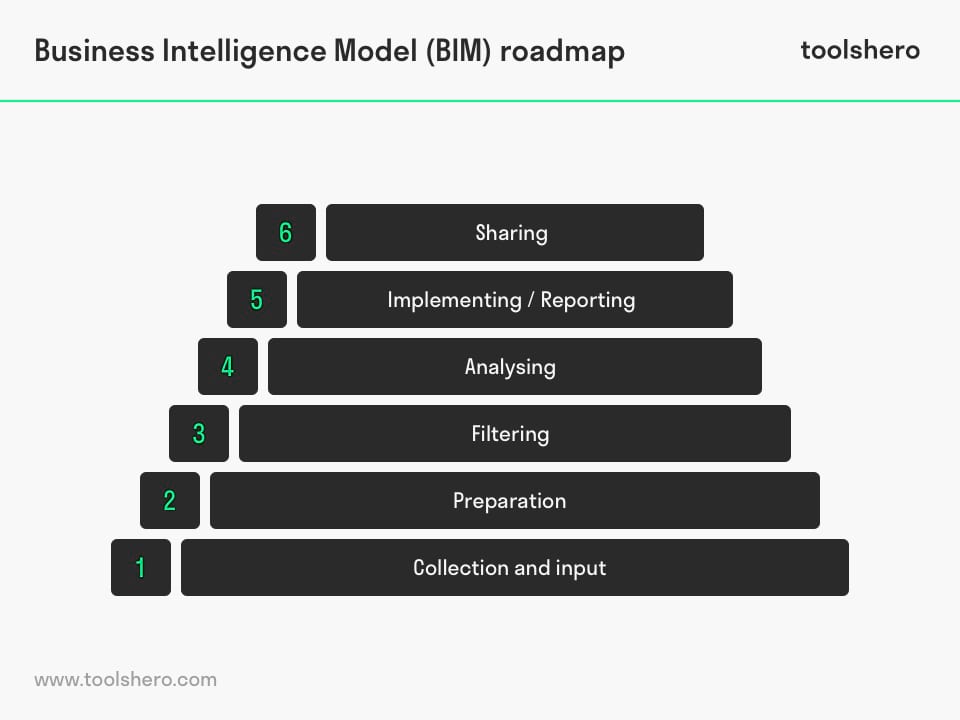Business Intelligence Model explained

Business Intelligence Model: this article provides a practical explanation of the Business Intelligence Model (BIM). Next to what it is, this article also highlights the applications and tools and the roadmap. After reading, you’ll understand the basics of this business strategy tool. Enjoy reading!
What is the Business Intelligence Model (BIM)
The Business Intelligence Model (BIM) is a model that offers opportunities for businesses to transform raw data into meaningful and useful information, in order to build an effective strategic plan, as well as create tactical and operational insights for decision-making within a given timeframe.
In the end, this knowledge needs to get to the right people, at the right moment, and via the right channel. Organisations collect large quantities of information. These are often raw data, such as facts and large data chains.
This information, data, needs to be processed and interpreted because it opens up new opportunities within the organisation, which may result in a competitive advantage.
The purpose of Business Intelligence (BI) depends on the strategy of the organisation. This is often derived from the business goal or mission statement.
Richard Millar Devens presented the term Business Intelligence (BI) to the Cyclopaedia of Commercial and Business Anecdotes in 1865. Later, in 1958, IBM computer scientist Hans Peter Luhn published an article about the potential of BI through the use of technology.
Business Intelligence Applications and Tools
Business Intelligence (BI) is not a product or system in itself. More often, the Business Intelligence Model (BIM) is referred to as an architecture that includes a collection of integrated applications and databases which support operations and the decision-making process.
These provide the business world with easy access to business and market data. Such Business Intelligence applications support activity and decision support systems (DSS), systems, reports, online analytical processing (OLAP), static data analyses, prognosis, and data mining.
DSS
The Decision Support System (DSS) is a computer support system used by managers and planners for decision-making. DSS combines human thinking and modelling systems in order to make well-informed and considered decisions.
For instance, DSS is used in logistical solutions. A business with a large inventory list can use DSS to generate movement in the supply chain.
OLAP in the Business Intelligence Model
Online Analytical Processing (OLAP) is another effective IT solution that is much used in the decision-making process of the business world. With this system, it is possible to quickly make calculations for analyses and reporting, two important elements in the decision-making process.
The system has access to centralised business data which it rapidly analyses. The insights formed here are used in the decision-making process. Applications such as DSS and OLAP also appear in the Business Intelligence Model (BIM).
OLAP, not to be confused with OLTP, is often accompanied by huge quantities of data, Big Data. Think of bank employees who analyse what the online banking behaviour of their customers looks like.
OLAP first requests data from the bank accounts of all customers, analyses user activity, and then presents the insights in a uncomplicated way.
Data Warehouses
The software needs to access a lot of data, centralised or decentralised, for the use described above. Data comes in different shapes and sizes.
Some data comes from systems, other comes from a database that was managed by a certain department, etc. It often concerns automatically generated reports, or manually kept lists in Excel.
Business Startup Blueprint & Business Intelligence
Business Intelligence Model (BIM) Roadmap
Business Intelligence (BI) is often considered to be more difficult than it really is. Naturally, the collecting and processing of business or market sensitive information is a delicate process, but it becomes easier with the six-step roadmap from the Business Intelligence Model (BIM).

Figure 1 – the Business Intelligence Model Roadmap
1. Collection and Input
The first step is collecting the data and connecting them to the Business Intelligence (BI) system. Depending on which system is used, the system can be ordered to get as much relevant data from a centralised database as possible, but Excel documents can also be added. There is a high diversity in types of sources and data and those all have their own way of requesting and input.
2. Preparation
Following input, not all data is available in the correct format. This is especially the case when multiple types of data, for example qualitative and quantitative information, are to be used together.
This means the data must often be prepared for the analysis. This happens in the preparation phase. Here, raw data is transformed into a clear collection of data.
This phase generally takes a lot of time, but it is essential for reliable and efficient analysis. Raw data can be logged in statistical software like IBM’s SPSS, which cleans it and divides it into categories. If the data sets are large, as is the case with Big Data, other, advanced technologies are needed.
3. Filtering
Now that all the data has been collected, cleaned, and entered, a selection must be made with relevant data. It may be the case that the customer behaviour data of the past five years are available, but the manager only wants to use the data of the past two years.
4. Analysing
Once the data are in a workable format, actual analysis can start. This is what it is about in the Business Intelligence Model (BIM). This it where it is decided which cross-section must be made of the data.
Averages per month and year, per segment, correlations between two variables, everything the organisation desires at that moment. The possibilities with data are endless and additional insights can be made by adding calculations.
5. Implementing / Reporting
The analysis is summarised in an analysis model. An effective analysis model makes it possible to easily and clearly gain insight based on reports and dashboards.
This is called implementation and forms the basis for, for instance, a strategic choice. The implementation can take place in different ways: professional reports, simple number lists, interactive graphic result tables, infographics, etc.
6. Sharing
During the final phase of the Business Intelligence Model (BIM), one considers how the results that were given shape in the previous phase will get to the right people at the right time.
This is often done by composing a quick email with an Excel document attached. However, there is a danger that different versions of the same file will get mixed up.
More complex information solutions often have an internal information portal. Reports and dashboards are available here for everyone who has been given access.
Business Intelligence Model: Privacy and Data
Organisations collect and analyse so much data about, for instance, consumers that governments all around the world have created strict provisions intended to give consumers control over the way in which their data are being collected and used.
The European Union has the GDPR for example: The General Data Protection Regulation became effective in 2018.
The United States use the comparable California Consumer Privacy Act (CCPA). These general regulations implement provisions for businesses when collecting, storing, using, and sharing of data. If organisations do not follow the rules they can expect severe punishment.
Now it’s your turn
What do you think? Are you familiar with the explanation of the Business Intelligence Model (BIM)? How do you use Business Intelligence (BI) within your organisation or activities? What do you think are the crucial aspects for collecting, analysing, and processing raw data? Do you have any tips or additional comments?
Share your experience and knowledge in the comments box below.
More information
- Anandarajan, M., Anandarajan, A., & Srinivasan, C. A. (Eds.). (2012). Business intelligence techniques: a perspective from accounting and finance. Springer Science & Business Media.
- Lahrmann, G., Marx, F., Winter, R., & Wortmann, F. (2011, January). Business intelligence maturity: Development and evaluation of a theoretical model. In 2011 44th Hawaii International Conference on System Sciences (pp. 1-10). IEEE.
- Barone, D., Yu, E., Won, J., Jiang, L., & Mylopoulos, J. (2010, November). Enterprise modeling for business intelligence. In IFIP Working Conference on The Practice of Enterprise Modeling (pp. 31-45). Springer, Berlin, Heidelberg.
How to cite this article:
Janse, B. (2019). Business Intelligence Model (BIM). Retrieved [insert date] from Toolshero: https://www.toolshero.com/strategy/business-intelligence-model-bim/
Original publication date:: 25/04/2019 | Last update: 12/22/2023
Add a link to this page on your website:
<a href=”https://www.toolshero.com/strategy/business-intelligence-model-bim/”>Toolshero: Business Intelligence Model (BIM)</a>












